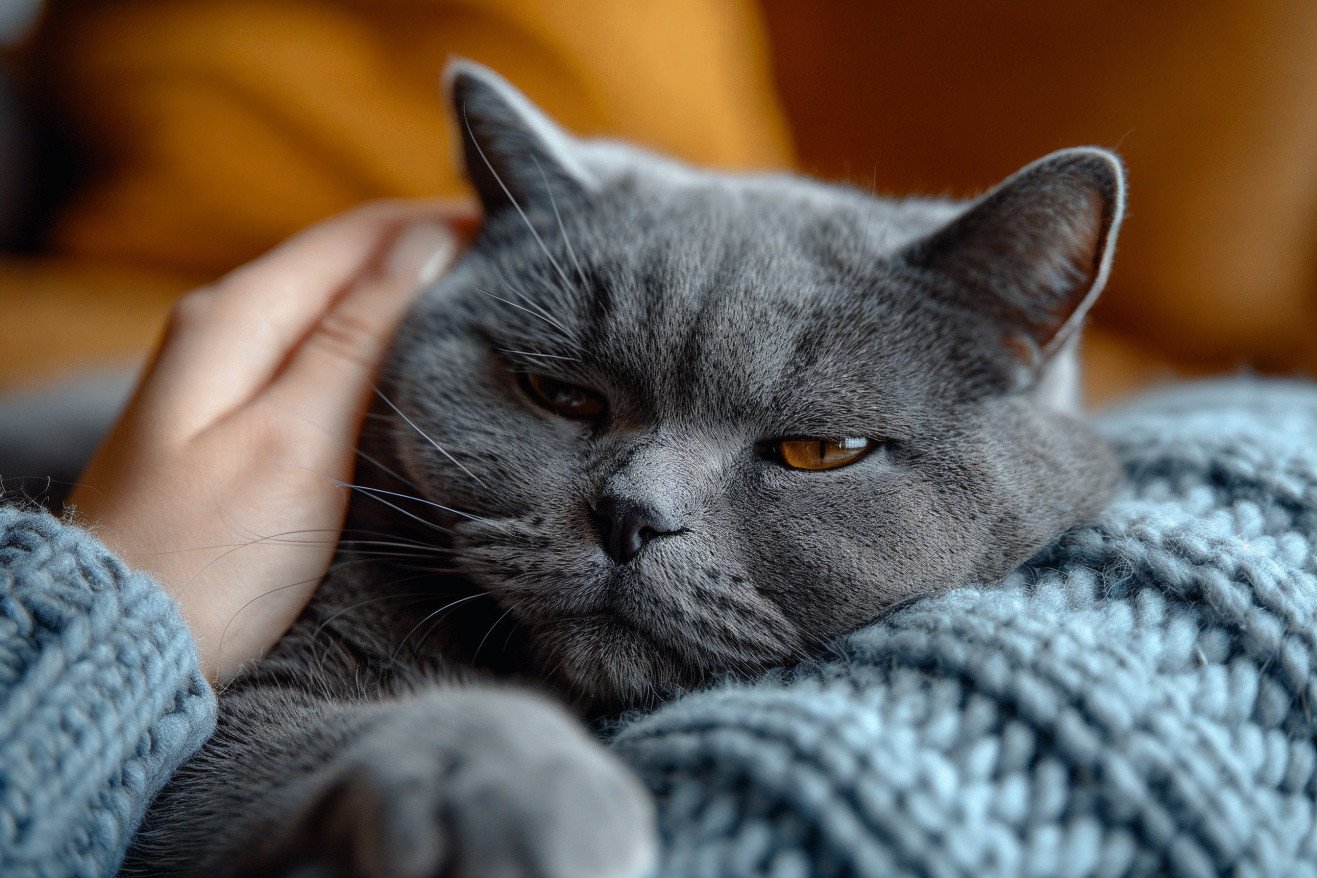Why Are My Cat’s Ears Hot? Decoding Feline Ear Temperature
4 February 2024

If you’ve ever felt your cat’s ears and noticed that they’re warm, you’ve probably wondered if that’s normal or if it’s a cause for concern.
It turns out that a variety of factors can cause a cat’s ears to feel warm, including a higher body temperature, exposure to heat, and stress.
However, if your cat’s ears feel hot and your cat is also experiencing other symptoms like tiredness or a lack of appetite, it could be a sign of a fever or an ear infection. If you’re worried about your cat’s health, it’s important to see a vet.
To help you better understand why your cat’s ears might feel hot, we’ve looked at the latest research and expert insights on feline physiology, common health problems, and environmental factors that can impact cats. Our aim is to provide an in-depth analysis of the research on feline ear temperature so that you can tell the difference between harmless issues and issues that require medical attention.
This way, you can feel more confident in your ability to assess your cat’s health and know when to seek help from a professional.
What are the most common causes of hot ears in cats?
Why Are My Cat’s Ears Warm?
According to Cedar Animal Medical Center, cats have a higher body temperature than humans, with a normal range of 101 to 102.5°F. This means that it’s normal for a cat’s ears to feel warm to the touch. The temperature of the environment can also play a role, with a cat that’s sitting in the sun or a warm room having warmer ears as their body temperature adjusts.
Stress and excitement can also cause a cat’s ears to feel warm. According to Catster, environmental stressors like moving to a new home can cause a cat’s ears to feel warmer. While this is generally nothing to worry about, it’s important to take the cat’s situation into account.
There are also health issues that can cause a cat’s ears to feel warm, including ear mites, infections, and fevers. According to PetHelpful, these issues will usually be accompanied by other symptoms like itching, discharge, or changes in behavior. If your cat’s ears feel warm and there are other symptoms present, it may be time to look into potential health issues.
Red Flags: When Hot Ears Are a Sign of Sickness in Cats
If your cat has one hot ear, it’s probably nothing to worry about. However, if your cat’s ears are consistently hot and there are other symptoms present, it could be a sign of an underlying health issue.
According to Bishop Ranch Veterinary Center & Urgent Care, if your cat is also experiencing lethargy and a change in appetite, consistently hot ears could be a sign of an underlying issue.
A fever, which is when your cat’s body temperature is over 103.5°F, is a sign that there’s more going on than just hot ears. While a temporary spike in ear temperature due to environmental factors or excitement is normal, a fever is the body’s way of fighting off an infection and should be checked out by a vet if it lasts for more than 48 hours.
MetLife Pet Insurance explains that changes in behavior like excessive scratching or head shaking could be a sign of ear infections or mites, which would cause your cat’s ears to be warm and uncomfortable.
It’s also important to look for visual signs of ear infections; redness, swelling, or discharge in the ear canal should be checked out by a vet.
Pay attention to these symptoms over time to see if your cat needs to see a vet. If you notice any discoloration around the ear canal, changes in behavior, or strange smells, you should contact a vet. Being aware of these red flags can help ensure that your cat stays healthy and happy.
The Balancing Act: How Cats Maintain Their Body Temperature
Cats are skilled at maintaining their body temperature, and their ears are a key part of this thermoregulatory process. The large size of a cat’s ears allows for more heat exchange with the environment, which helps cats cool down and, in turn, helps them maintain their body temperature.
However, dehydration can interfere with a cat’s ability to maintain its body temperature. A study in PubMed found that dehydration reduces a cat’s evaporative water loss, which is an important way cats cool themselves, especially in hot environments.
In addition to dehydration, normal behaviors like grooming and panting are also ways that cats cool themselves down. Grooming helps cats cool down because the saliva on their skin evaporates and cools them down, while panting helps cats release heat from their bodies. However, both of these processes are less effective when a cat is dehydrated.
Dehydration has a big impact on a cat’s ability to maintain its body temperature. As the cat’s body tries to conserve water, it may reduce the amount of cooling that happens when a cat pants, which could lead to warmer ears as a result.
In addition, a cat’s ability to maintain its body temperature is also influenced by other factors like the density of its fur and breed differences, with some breeds being better able to handle temperature changes than others.
It’s important for cat owners to understand the role that hydration and the environment play in their cat’s ability to maintain its body temperature. Making sure cats have access to fresh water and keeping the temperature in their home at a comfortable level can help prevent overheating and support ear and overall health.
The Anatomy and Physiology of a Cat’s Ear
The ear of a cat is a highly specialized organ that is not only responsible for hearing but also for regulating body temperature. A study published on PubMed explains that the external ear, or pinna, and the ear canal are important for sound collection and also help regulate body temperature by allowing heat to dissipate from the body.
If either of these areas become blocked or infected, it can lead to a disruption in the cat’s ear temperature. The eardrum, or tympanic membrane, is important for hearing and can also impact the temperature of the cat’s ear.
This membrane vibrates when sound waves hit it, and if there are any changes in the middle ear, such as inflammation or the buildup of fluid, it can lead to a cat’s ear feeling warm as the body sends more blood to the area to fight off the infection.
Cornell University College of Veterinary Medicine explains that it’s important to check your cat’s ears regularly to ensure that there are no issues, such as ear mites, hematomas, or infections. Catching these issues early can prevent more serious problems, such as deafness or vestibular disorders, which shows how important it is to understand the anatomy of a cat’s ear in relation to their overall health.
Make sure you check your cat’s ears regularly to ensure that you catch any ear issues, including ear mites and infections, before they become serious. This will help ensure that any changes in ear temperature are considered in light of the cat’s overall ear and health.
When to See a Vet About Your Cat’s Hot Ears
If your cat’s ears are warm all the time and you’re noticing other symptoms like behavioral changes, changes in appetite, or excessive scratching, it’s time to see a vet. While a slightly higher body temperature is normal for cats, fevers and infections can cause hot ears and other symptoms that need to be treated by a vet.
A vet can perform a physical examination that can help determine if your cat has an ear issue or a more systemic health problem.
If your cat has an ear infection or another bacterial infection, your vet will likely prescribe antibiotics. If your cat has ear mites, your vet will prescribe a medication that can help eliminate the mites.
It’s important to take your cat to the vet for regular check-ups, as untreated ear infections can lead to hearing loss and other complications. Make sure to follow your vet’s instructions for treatment and any other care that you need to provide at home.
You can help your vet provide the best care for your cat by being as detailed as possible when you describe your cat’s symptoms and by providing a thorough health history. Make sure to let your vet know about any behavioral changes that you’ve noticed.
You can also help your vet by paying close attention to your cat’s normal behavior and physical condition. This will help you notice any changes that you can report to your vet. This will help your vet take a more holistic approach to your cat’s care.
Conclusion
So, in conclusion, there are a number of reasons why your cat’s ears might be warm. Most commonly, it’s due to the fact that cats have a higher body temperature than humans, which is a normal physiological difference.
However, environmental factors, stress, and even sunbathing can all cause a cat’s ears to feel warm. That said, if your cat’s ears are warm and they are showing other symptoms like lethargy, a lack of appetite, or signs of ear pain, it could be a sign of an underlying health issue that needs to be addressed by a vet.
The most important thing to keep in mind when it comes to your cat’s ear temperature is to stay vigilant. Pay attention to the way your cat is acting and feeling in relation to the temperature of their ears. Good cat owners will make sure to check in on their cat’s health regularly and get professional advice when it’s needed.
Knowing the ins and outs of feline physiology is important, not just for the sake of knowledge but for the sake of good pet care. With this information, you’ll be better equipped to recognize when your cat is in pain or distress, which will help you ensure that they have the best quality of life possible.
Your ability to recognize and respond to their needs is evidence of the special relationship you have with your cats, a relationship that’s built on a foundation of love and understanding.


